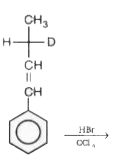Alkenes undergo :
addition reactions
substitution reactions
Both (A) and (B)
None of these
To solve the question "Alkenes undergo:", we will analyze the types of reactions that alkenes typically participate in.
1. Understanding Alkenes:
- Alkenes are hydrocarbons that contain at least one carbon-carbon double bond (C=C). This double bond is a key feature that influences their reactivity.
Hint: Remember that the presence of a double bond in alkenes is crucial for their chemical behavior.
2. Addition Reactions:
- Alkenes readily undergo addition reactions due to the presence of the double bond. In these reactions, atoms or groups of atoms are added to the carbon atoms involved in the double bond, breaking the double bond and forming a single bond.
- Common addition reactions include hydrogenation (adding H2), halogenation (adding Cl2 or Br2), and hydrohalogenation (adding HX).
Hint: Focus on how the double bond allows alkenes to react with other molecules by adding to them.
3. Substitution Reactions:
- Although alkenes primarily undergo addition reactions, they can also participate in substitution reactions under certain conditions. In a substitution reaction, one atom or group in the alkene is replaced by another atom or group.
- For example, when ethylene (an alkene) reacts with chlorine, one hydrogen atom is replaced by a chlorine atom, resulting in vinyl chloride.
Hint: Consider scenarios where an atom in the alkene can be replaced rather than added to.
4. Conclusion:
- Since alkenes can undergo both addition and substitution reactions, the correct answer to the question is that alkenes undergo both types of reactions.
Final Answer:
Alkenes undergo both addition and substitution reactions.
Options:
- A: Addition reaction
- B: Substitution reaction
- C: Both A and B
- D: None of these
Correct Option: C (Both A and B)
- Alkenes are hydrocarbons that contain at least one carbon-carbon double bond (C=C). This double bond is a key feature that influences their reactivity.
- Alkenes readily undergo addition reactions due to the presence of the double bond. In these reactions, atoms or groups of atoms are added to the carbon atoms involved in the double bond, breaking the double bond and forming a single bond.
- Common addition reactions include hydrogenation (adding H2), halogenation (adding Cl2 or Br2), and hydrohalogenation (adding HX).
- Although alkenes primarily undergo addition reactions, they can also participate in substitution reactions under certain conditions. In a substitution reaction, one atom or group in the alkene is replaced by another atom or group.
- For example, when ethylene (an alkene) reacts with chlorine, one hydrogen atom is replaced by a chlorine atom, resulting in vinyl chloride.
- Since alkenes can undergo both addition and substitution reactions, the correct answer to the question is that alkenes undergo both types of reactions.
Alkenes undergo both addition and substitution reactions.
- A: Addition reaction
- B: Substitution reaction
- C: Both A and B
- D: None of these
Topper's Solved these Questions
- HYDROCARBONSBOOK - VMC MODULES ENGLISHCHAPTER - HYDROCARBONSEXERCISE - Level-2
50 Videos
- HYDROCARBONSBOOK - VMC MODULES ENGLISHCHAPTER - HYDROCARBONSEXERCISE - Level-2 (Numerical Value Type)
15 Videos
- HYDROCARBONSBOOK - VMC MODULES ENGLISHCHAPTER - HYDROCARBONSEXERCISE - Level-0 Long Answer Type (5 Marks)
1 Videos
- HALOALKANES AND HALOARENESBOOK - VMC MODULES ENGLISHCHAPTER - HALOALKANES AND HALOARENESEXERCISE - IN-CHAPTER EXERCISE - F
6 Videos
- ICONIC EQUILIBRIUMBOOK - VMC MODULES ENGLISHCHAPTER - ICONIC EQUILIBRIUMEXERCISE - IMPECCABLE
50 Videos
Similar Questions
(a) The double bond in aldehydes and ketones is reactive towards nucleophilic reagents like CN− whereas that in an alkene is not.
(b) Alkenes undergo electrophilic addition whereas aldehydes and ketones undergo nucleophilic addition.
View SolutionWhy do alkenes and alkynes undergo addition reactions ? Describe some important addition reactions of alkenes and alkynes.
View Solution
Knowledge Check
Vladimir Markovnikov rule : Alkenes undergo electrophilic addition reactions. It is triggered by the acid acting as a electrophile toward t-electrons of the double bond. Markovnikov's rule states that when an unsymmetrically substituted alkene reacts with a hydrogen halide, the hydrogen atom adds to the carbon that has the greater number of hydrogen, e.g.,

In which of the following reactions, diastereomers will be formed ?A B
B C
C DAll of these
DAll of theseVladimir Markovnikov rule : Alkenes undergo electrophilic addition reactions. It is triggered by the acid acting as a electrophile toward t-electrons of the double bond. Markovnikov's rule states that when an unsymmetrically substituted alkene reacts with a hydrogen halide, the hydrogen atom adds to the carbon that has the greater number of hydrogen, e.g.,

In which of the following reactions, product is racemic mixture ?ACH3−CH2−CH=CH2HBr−−→CCl4B C
C DAll of these
DAll of these
An alkyl bromide produces a single alkene when it reacts with sodium ethoxide and ethanol. This alkene undergoes hydrogenation and produces 2-methylbutane. What is the alkybromide ?
View SolutionArrange the following alkenes in order of their stability

View SolutionWhich of the following alkenes does not undergo rearrangement on heating with a strong acid?
View SolutionWhich of the following alkenes does not undergo rearrangement on heating with a strong acid?
View SolutionWhy do alkenes prefer to undergo electrophilec addition reaction while arenes prefer electrophilic substitution reactions ? Explain.
View SolutionThrough which mechanism does HBr undergo reaction with unsymmetrical alkenes?
View Solution
